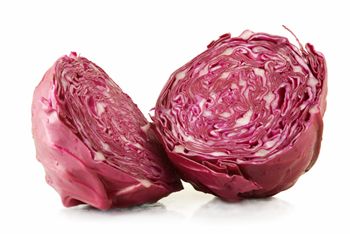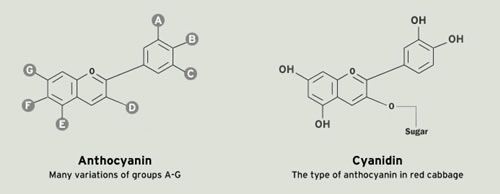A page from the "Causes of Color" exhibit...
Organic Color Changes with Acids and Bases

A collection of household items and vegetables can make for an interesting afternoon. Long before chemical indicators were synthesized, chemists in the 1600s used plant and vegetable dyes.
Materials
- Small head of red cabbage
- 3-quart pot
- 2-3 cups water
- Strainer
- Empty 16-24 oz. glass jar
- Variety of soaps
- Baking soda
- Variety of fruit juices
- Measuring cup and measuring spoons
- White vinegar
- Ten 8-oz. clear plastic cups
- Black Sharpie
- Coffee stirrers or plastic spoons
What To Do
- Chop the red cabbage into large pieces.
- Place the cabbage in a 3-quart pot and add 2-3 cups water. Bring to a boil, and then simmer until the cabbage is almost white.
- Strain the cooking water (“cabbage juice”) into the glass jar. Let cool.
- Use the Sharpie to number each of 10 clear plastic cups.
- Place the plastic cups in numerical order on a counter or table. Pour 4 oz. of water into cups 1 through 9.
- Place a different liquid soap or small piece of solid soap into each cups numbered 2 through 5. Stir to dissolve the soaps.
- Add 1 tablespoon of fruit juice to cup 6. Add 1 tablespoon of a different fruit juice to cup 7, another to cup 8, and another to cup 9.
- Add 1 tablespoon of baking soda to cup 1, and stir until it is dissolved.
- Pour 4 oz. of white vinegar into cup 10.
- Your line up of cups should have baking soda at one end with the soaps, and the vinegar at the other end with the fruit juices.
- Add one teaspoon of red cabbage juice to each cup. Notice the differences and the similarities in colors.
When mixed with the anthocynanins found in cabbage, acids and bases can produce a variety of colors.
How It Works
Acids and bases are chemical opposites and have opposing effects on indicators. A common indicator, called litmus, is obtained from a plant called a lichen. Other indicators are liquids synthesized in chemistry labs, although the first indicators were plant and flower extracts. See information about pH indicators.
The molecule in red cabbage responsible for the colors is an anthocyanin. Anthocyanins are a large group of red-blue plant pigments that occur in all higher plants. They occur mostly in flowers and fruits, but are also present in leaves, stems, and roots. It colors many of our foods, from blueberries to red wine.
All anthocyanins have a basic core structure (the flavyllium ion), with a few variations in the side-groups (A-G) attached on the edges of the molecule, a hydrogen atom, a hydroxide ion, a methoxy-group, and at least one sugar. Over 500 different anthocyanins have been isolated from plants. Cyanidin is the variation found in red cabbage.
Notice the three rings on the left in the diagram above. The electrons of the ring structures interact with incoming light and absorb various frequencies. As the side groups vary, the frequencies of electrons vary. In anthocyanins, smaller side groups tend to keep absorption on the shorter wavelengths (producing blue colors), and larger side groups cause the absorbed wavelengths to be a bit longer (producing red colors)
In addition to the side groups, the environment of the cyanidin molecule you extracted from red cabbage affects the molecule. The molecule is in solution, and the hydroxide groups (OH) often give up their hydrogen atoms, as ions, into the surrounding water. When they temporarily lose the H, their resonant frequency shifts a bit towards shorter wavelengths. This is the effect:
Drag the slider to see how the colors and absorption maxima of red cabbage’s cyanidin pigment vary with pH.
What’s happening? When you change the concentration of hydronium ions (H3O+) in the water, you affect the probability that the Cyanidin will keep or lose some of its Hs – you are affecting the shape of he molecule. Thus, by making the solution more acidic (lower pH and more hydronium ions), or more basic (higher pH and fewer hydronium ions), you cause the cyanidin to change its structure, which then changes the absorbed wavelengths.
Color changes are basically caused by changes in electron movement or confinement in a double bond. More confinement makes the light absorbed bluer (shorter wavelength), and less confinement makes it redder (longer wavelength). When a hydrogen ion combines with the basic form of an indicator, it will confine two formerly mobile electrons to a single covalent bond with the hydrogen shifting the light that is absorbed toward the blue end of the spectrum.
In this activity the vinegar is a 5% solution of acetic acid and the fruit juices have citric acid. The baking soda is sodium bicarbonate and the soaps have sodium hydroxide as an ingredient. The color changes are usually in the red family for acids and in the green family for bases. Some soaps might be green with the red cabbage juice. A purple color would be close to neutral (neither acid or base.)
Variations
You can test your tap water with red cabbage juice. If you have hard water, your town or municipality probably treats the water with potassium hydroxide. This causes the copper and/or iron to precipitate out as copper or iron hydroxide, which would test as a chemical base. Distilled water is neutral and spring water is probably neutral.
Other substances around the house, such as shampoos, conditioners, and cleaning supplies, can be tested. Many shampoos are pH balanced, which would make them slightly acidic as opposed to basic. Carbonated beverages can test as acids because they contain carbonic acid from the carbon dioxide gas dissolved in the water.
Some soaps will test neutral. They are not caustic or dehydrating. Many bath soaps are extremely basic. It is interesting to test the soaps that you use to shower.
Beet juice can be prepared the same way as red cabbage juice, and rose petals can be ground with a mortar and pestle and dissolved in rubbing alcohol.
It is an interesting challenge to try to make the cups of liquids change color from red to purple to green to blue. Add vinegar to the soaps a little at a time and add baking soda to the acids to change the color.






